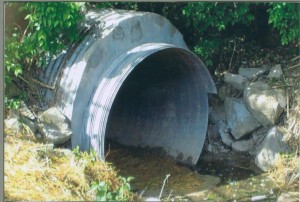July 2012, Vol. 67, No. 7
Features
Spiral Lining Solution For Indiana Culverts

Earlier this year, the Indiana Department of Transportation (INDOT) used spiral wound pipe liner to rehabilitate two failing culverts beneath Interstate Highway 64 (I-64) near Evansville in the southwest corner of the state. It was the first time this product and installation process has been used by INDOT.
The two 66-inch diameter corrugated metal pipes (CMP) were located on each side of a CSX railroad track under a bridge embankment which carries I-64 traffic over the railroad. One was 210-feet in length, the other 246 feet.
The culverts were installed in 1966 with concrete paved inverts added in 1996. A 2009 inspection revealed heavy rusting and pitting above the paved inverts, as well as several deflections in the pipes.
INDOT wanted to evaluate machine spiral wound lining as a possible alternative to HDPE slip lining for culvert rehabilitation in areas of limited access and/or limited right-of-way, said an INDOT spokesperson.

This location, he continued, was chosen due to the limited right-of-way access and the improvement in hydraulic capacity and efficiency of the machine spiral wound PVC liner due to a larger open-end area compared to a traditional HDPE liner. The largest solid wall HDPE liner that would have fit in the host would have been 48 inches outside diameter with 44.89-inch inner diameter (ID), or a 48-inch ID profile wall HDPE liner. The 54.5-inch ID spiral wound PVC liner offered the largest inside-diameter liner that could successfully be installed to provide the greatest possible hydraulic capacity.
Both culverts were relined with Sekisui SPR PVC machine wound spiral pipe, said Karl Bates, project manager/estimator with Indiana Reline, contractor for the project. Sekisui SPR utilizes a steel-reinforced, monolithic, interlocking PVC profile strip that is grouted in place with specified cementitious grout. SPR has the capability to negotiate bends and rehabilitate odd shaped pipelines because of the adaptability of the profile.
Because INDOT and CSX had virtually no experience with the installation of spiral PVC liner, the project began with preparation and submitting a quality control/quality assurance plan for the installation of the Sekisui SPR liner.
A job apart
The basic installation process is to position a winding machine at the base of an access point of the host pipe and spirally wind monolithic panels of PVC into the host pipe to form a continuous, low-weight, watertight liner with high stiffness.
Several factors set this project apart from typical spiral wound liner installations.
“Indiana Reline was required to comply with CSX railroad policies for construction near active rail lines, including keeping all equipment and material at least 13 feet from the center of any line, and having a railroad flagman present at all times during construction,” said Bates.
After mobilization and general project set-up and equipment unloading, Indiana Reline established a coffer dam and erosion control measures. After dewatering, the existing concrete paved invert was removed and the culvert cleaned. Blocking, bracing and two-inch PVC grout tubes were installed.
“In lieu of runners, our crews utilized a unique method on the invert of the host pipe to facilitate easier installation by creating a smooth surface over which to install the liner,” Bates said. “Liner was wound at an inside diameter of 54.5 inches with an outside diameter of 56 inches.”
After successful installation of the liner, wood struts were installed to prevent deformation of the liner during the annular space grouting. Two-foot thick concrete bulkheads were constructed at each end of the lined culvert to contain the cellular grout. After the initial cure period the wood struts were removed and the bulkheads were faced off with mortar.
The 246-foot culvert was lined first followed by the 221-foot culvert.
Construction began in mid-December 2011 and was completed in mid-April 2012. Several weather delays slowed progress of the work.
Indiana Reline and INDOT were pleased with the outcome of the project. “As with any innovative project there are many challenges to overcome, this project was no exception,” said the INDOT spokesperson.
“Machine changes and the process of spiral wound pipe had to be tweaked. This tweaking was successful and moved along according to plan. Indiana Reline and Sekisui representatives were very accommodating during this entire process and are giving INDOT a successful project.”
FOR MORE INFO:
Indiana Reline, (877) 533-5040, www.indianareline.com
Sekisui SPR Americas, (678) 510-1820, www.sekisui spr.com




Comments